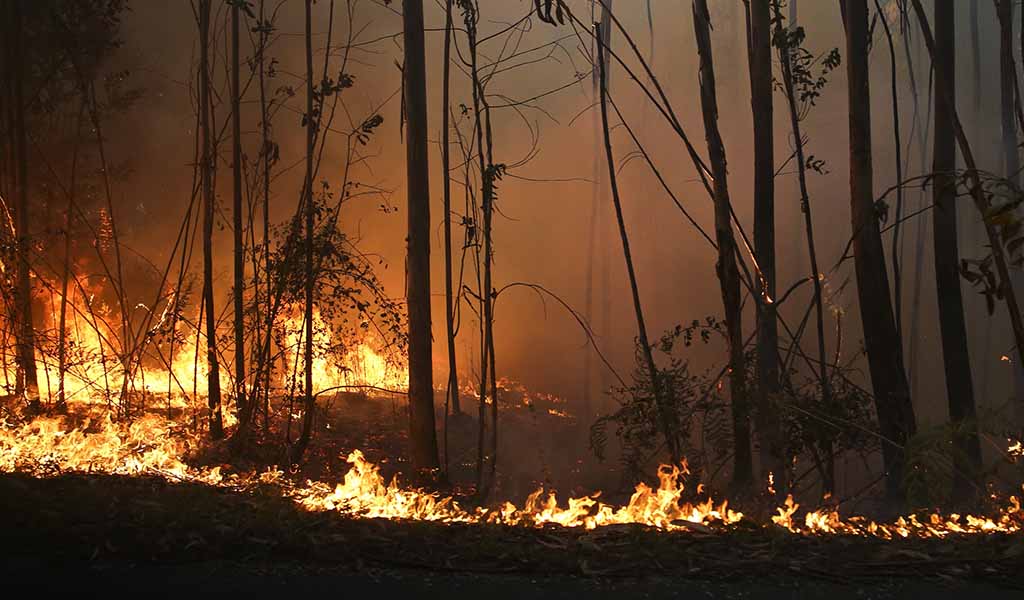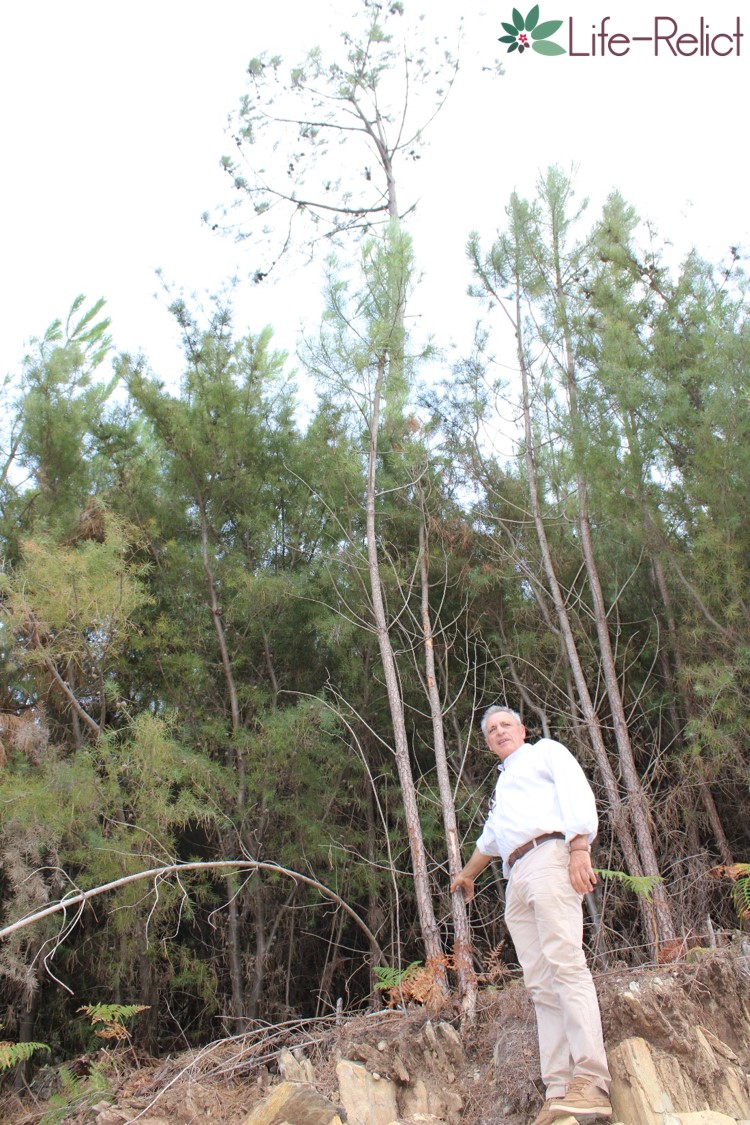-
Fire
 This is one of the most serious threats to the habitat in Portugal. As is the case throughout the Mediterranean region, fire is a recurring phenomenon in the Iberian Peninsula due to the type of vegetation existing and, above all, to the numerous anthropogenic pressures to which the territory is subjected.
This is one of the most serious threats to the habitat in Portugal. As is the case throughout the Mediterranean region, fire is a recurring phenomenon in the Iberian Peninsula due to the type of vegetation existing and, above all, to the numerous anthropogenic pressures to which the territory is subjected.
The borderline situation of Portuguese Laurel and Pontic Rhododendron, with very isolated, fragmented and ending populations, makes fire one of the most serious threats to the future permanence of these formations on the European continent. Fire is responsible for the effective destruction of the habitat, the loss of biodiversity and, most importantly, the impoverishment of the edaphic conditions that limits the resettlement of this habitat in a post-fire situation.
In addition, in the interventions areas of Life-Relict Project, fire is a constant, which annually consumes hundreds of hectares of forest. For example, in the Serra da Estrela area, surrounding the village of Casal do Rei, the Portuguese Laurel forest burned in 2005, completely destroying this emblematic habitat, which the local population called “our garden”. This example makes clear the need to protect and conserve other habitat areas to ensure their future preservation.
In the particular case of Pontic Rhododendron, although it has the ability to regenerate vegetatively, the floristic composition and ecological function of the habitat are severely affected after fire. This situation is particularly worsened when fires recur and consequent changes in local edaphic conditions. The reduction of soil water thickness and retention capacity leads to the progressive disappearance of R. ponticum due to lack of installation conditions (Mejías et al, 2002 and 2007).
Life-Relict aims to reduce the risk of fire by taking measures to prevent the rapid progression of fire. These include the elimination of pyrophyte species in all project intervention areas and the conversion of surrounding areas to autochthonous forests to create buffer zones that slow the spread of fire. Also the removal of exotic species and awareness of the local population should contribute to reducing the risk and periodicity of fires.
-
Limited Capacity to Install New Plants
Studies carried out in the Spanish populations of Pontic Rhododendron (R. ponticum) indicate that these communities are almost unsuccessful in the natural establishment of new seedlings, even though the seeds are abundant and wind dispersed (Mejías et al., 2002). This will be due to the lack of suitable climatic conditions for the installation of new seedlings, in particular the dry periods that characterize the Mediterranean climate.
As a consequence, today’s populations are made up almost exclusively of adult individuals that come from vegetative regeneration. This situation leads to the low expandability of existing cores and to the creation of new cores. The consequences of this conjuncture could be severe in the medium term, with the widespread death of individuals, making existing cores even more important for the survival of the species, and their habitat, in the Iberian territories.
Being aware of this circumstance, the Life-Relict project included actions to increase the habitat occurrence area. To this end, a series of alternatives will be put in place and tested, which will allow conclusions to be drawn about the best practice for the installation of new seedlings and the increase of habitat areas.
-
Invasive Exotic Species
 Considered to be the second leading cause of global biodiversity loss (Marchante, 2005), they are also a major degradation factor in the project’s intervention areas. The most worrisome invasive alien species in the project’s intervention areas are Mimosa (Acacia dealbata) and silky hakea (Hakea sericea).
Considered to be the second leading cause of global biodiversity loss (Marchante, 2005), they are also a major degradation factor in the project’s intervention areas. The most worrisome invasive alien species in the project’s intervention areas are Mimosa (Acacia dealbata) and silky hakea (Hakea sericea).
These invasive alien species affect Pontic Rhododendron and Portuguese Laurel at various levels, such as:
1 – Compete with local vegetation, leading to the progressive degradation of native communities and the limitation of their occupation area;
2 – These are serious threats to the integrity and maintenance of the ecological function of existing formations;
3 – Indirectly, increase the risk and periodicity of fires;
4 – It is also impossible to expand existing habitat cores to the areas they occupy.
Life-Relict aims to combat invasive species existing in these territories through measures aimed at their detection and control in an attempt to eradicate.
-
Inadequate Forestry Interventions
Over the last few centuries, the potential territories of the Pontic Rhododendron and Portuguese Laurel have been subjected to great man-made pressures, including forestry pressures, with consequences that have been perpetuated to this day. These include plantations of a set of forest species (mainly pine and eucalyptus), associated with clearing soil for cultivation. Plantations, such as of eucalyptus, remain a reality especially in the northern part of the country.
These interventions lead to the disappearance and decay of previously existing habitat cores and currently contribute to an impoverished of the conservation status of the habitat 5230*. The presence of areas of pine or eucalyptus within the patches of other habitats potentiate the phenomena of halelopathy or soil podzolization, conditioning the installation of native species. In addition to this degradation factor is the increased incidence of forest fires and significant soil losses (resulting from burping, fire, etc.).
The Life-Relict project aims to improve habitat quality by removing species outside the system and will try to minimize the risk of fire.
-
Climate Change
Several studies have suggested that relic communities of Laurissilva present in the European continent, including Pontic Rhododendron (R. ponticum subsp. baeticum) communities, have reduced responsiveness to negative events such as climate change (Mejías et al, 2002, Calleja et al., 2009). This is due to a set of circumstances spearheaded by climate requirements, small and isolated populations, and the continuing anthropogenic pressure typical of the Mediterranean region.
Climate predictions for Iberian Peninsula threaten the survival of the species in this territory, as already rare and fragmented populations may see their niches even smaller (Mejías et al., 2002 and 2007; Calleja et al. , 2009). At the same time, climate change is capable of simultaneously enhancing all other risk factors mentioned above.
As the main objective of Life-Relict project is to improve the conservation status of the habitat, all planned conservation actions are aimed at improving the quality of population cores in an attempt to improve the resilience of the system to climate change, enhancing its capacity of survival. In addition, the Life-Relict project also aims to increase the habitat area, thus,will increase the future survival capacity of this habitat.
-
Other Threats
In addition to the threats already mentioned, there are other threats such as: physical destruction through inert and farming exploitation; opening of trails or paths; effluent discharge; excessive pedestrian traffic; and cutting for ornamental purposes.







